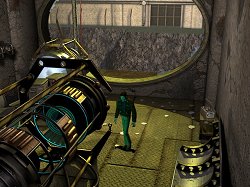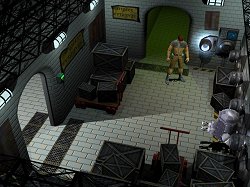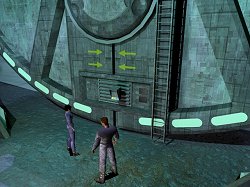|
In Cold Blood
 In Cold Blood is a keyboard-controlled game. Regular readers will know that I dislike keyboard-controlled adventure games, but it would be unfair for me to harp on this issue for two reasons. Firstly, the game was developed for another platform that uses a gamepad control system and not a mouse. Secondly, it is not a 'pure' adventure game but an action/adventure hybrid with the emphasis on action. In Cold Blood is a keyboard-controlled game. Regular readers will know that I dislike keyboard-controlled adventure games, but it would be unfair for me to harp on this issue for two reasons. Firstly, the game was developed for another platform that uses a gamepad control system and not a mouse. Secondly, it is not a 'pure' adventure game but an action/adventure hybrid with the emphasis on action.
Think of a James Bond movie; two super powers, in this case China and the US, heading for a nuclear showdown; a shadowy group in the background pulling the strings for their own evil purposes; and a lone British secret agent thrust into the middle of it armed only with his wits, gun and some nifty gadgets. This is the setting for In Cold Blood and why not? It is after all a successful movie formula. Almost to the very end the story unfolds in a series of flashback episodes misleadingly called 'missions'. Unlike other action games you cannot choose which mission you will undertake but must follow the strong narrative that some may label 'linear' in a pejorative way, but not me. When I read that the game had nine missions to complete my first thought was that I was going to play disjointed scenarios in any order, but this is not the case. Revolution's ability to tell a story has remained firm and it was perhaps this aspect above anything else that kept me playing.
In this third person perspective game, your on-screen character is John Cord and you are a prisoner in the hands of your enemies. You have been tortured and your captors are using drugs to make you tell them what you know. As the story progresses you know you have been betrayed, but by whom?
The actual gameplay is fairly repetitive; gain access to a variety of industrial-style complexes, knock out or kill the guards, threaten the technicians for information, avoid or immobilize the robots so that you can rescue the girl, find a missing agent, plant a bomb or reset the bomb someone else planted, prevent a missile launch, etc.
There are some inventory based puzzles, you must find pass cards, use a few items and access computers to get information and work out strategies. You can also talk to and interrogate other characters (apart from guards) and you do need to think about how to best proceed. Cord will sometimes prompt you about what you need to do, but the obstacles to progress are generally easy to overcome if you have been thorough and searched everywhere.
 As for the action components, they involve hitting, shooting, and scurrying around, punctuated by some timed interludes to increase the tempo. I played through the first two missions trying not to kill anyone and trying not to call attention to myself, but I didn't get far using this strategy as I 'died' a lot. I wasn't very good at sneaking up behind guards and usually by the time I had maneuvered Cord into the correct position to deliver a telling blow, the guard either moved out of range or turned around and shot me, or both. When I learned that there weren't any serious consequences to my shooting guards, and that I would be forced to do this anyway, I ceased sneaking and just shot first and the whole game became easier. I actually appreciated the fact that you could generally leave bodies strewn around and could intimidate technicians without someone raising the alarm, though there are one or two areas where more subtlety is called for and you quickly learn where these are. I say 'appreciated' only because it made the action easier to bear.
Less easy was dealing with the floating robots that no amount of bullets could kill. The strategy called for was quick keyboard navigation skills; enter a room while the robot had its back turned or was in a nearby corridor, plant a mine then run away before it spots you. I had to attempt this procedure numerous times because there are several of these pests throughout the game and I frequently couldn't get Cord through the door to safety in time. Still patience and persistence paid off, but it is not what I call fun and this sort of frustrating, repetitive gameplay is one of the main reasons that I am opposed to adventure games embracing action components. As for the action components, they involve hitting, shooting, and scurrying around, punctuated by some timed interludes to increase the tempo. I played through the first two missions trying not to kill anyone and trying not to call attention to myself, but I didn't get far using this strategy as I 'died' a lot. I wasn't very good at sneaking up behind guards and usually by the time I had maneuvered Cord into the correct position to deliver a telling blow, the guard either moved out of range or turned around and shot me, or both. When I learned that there weren't any serious consequences to my shooting guards, and that I would be forced to do this anyway, I ceased sneaking and just shot first and the whole game became easier. I actually appreciated the fact that you could generally leave bodies strewn around and could intimidate technicians without someone raising the alarm, though there are one or two areas where more subtlety is called for and you quickly learn where these are. I say 'appreciated' only because it made the action easier to bear.
Less easy was dealing with the floating robots that no amount of bullets could kill. The strategy called for was quick keyboard navigation skills; enter a room while the robot had its back turned or was in a nearby corridor, plant a mine then run away before it spots you. I had to attempt this procedure numerous times because there are several of these pests throughout the game and I frequently couldn't get Cord through the door to safety in time. Still patience and persistence paid off, but it is not what I call fun and this sort of frustrating, repetitive gameplay is one of the main reasons that I am opposed to adventure games embracing action components.
On a more positive note the backgrounds and cinematic cut sequences are excellent and the musical score swells with the dramatic tension illustrating further Revolution's quality production values in these areas. Yet, at the same time the characters are rather blurred and indistinct during the actual game, though I don't have a problem with this and I was thankful that Cord's voice and dialogue was not as aggressive as his feet-apart-hip-thrust-forward stance suggested. What did cause me some anguish was seeing all these beautifully rendered locations and being prevented from interacting with them. So many interesting-looking items were just background detail. Even when I maneuvered Cord into position and pressed the left Control key I rarely elicited a reaction.
This is the problem with this sort of game. The background scenery, no matter how stunning, is largely just background; fantastic eye-candy but hardly immersive if you can't actually 'touch' it. Sure you can get Cord to run down corridors and climb ladders, but in too many locations there is simply nothing to do. Once I realised that there are only a few spots where you can actually interact with the game environment such as computer terminals, door locks, robot recharge ports, the occasional lever, etc., I moved along at a much quicker pace. And clearly this is how the game is meant to be played. Leisurely and detailed exploration is not rewarded; that curious item standing out on top of the battered locker in the decrepit communal shower room is nothing. Ignore it. Having said that, there are a few rooms where it is necessary to interact with objects but these are not identified so there will be times when you need to move Cord in front or behind something and press the left Control key for a description. Some items you need conveniently twinkle like in the early King's Quest games, but not everything is so helpful.
I've touched briefly on some navigation issues, but I think it is fair to say that the keyboard navigation is imprecise and cumbersome. Cord will get stuck at doorways and other obstacles and he will go around in circles if you run him into an 'impenetrable' barrier.
 As well as the arrow keys for movement there is a key to make Cord run and another to make him crouch. The left Alt key makes him draw his gun and the spacebar fires it. If you press the spacebar without drawing the gun Cord will punch. You have a really useful wristwatch communication device called REMORA that you can access by pressing the delete key or you will sometimes access it automatically if you are facing a computer terminal and press the left Control key. The Enter key opens and closes your inventory. But the main way you interact within the game world is by pressing the left Control key. This key allows you to 'look', that is get a description if one is forthcoming; to 'talk' to another character; to 'take' an item, or to select an inventory item and use it; it also allows you to 'operate' levers and switches etc. It is the all-purpose interaction key ... and to think I used to complain about smart cursors. As well as the arrow keys for movement there is a key to make Cord run and another to make him crouch. The left Alt key makes him draw his gun and the spacebar fires it. If you press the spacebar without drawing the gun Cord will punch. You have a really useful wristwatch communication device called REMORA that you can access by pressing the delete key or you will sometimes access it automatically if you are facing a computer terminal and press the left Control key. The Enter key opens and closes your inventory. But the main way you interact within the game world is by pressing the left Control key. This key allows you to 'look', that is get a description if one is forthcoming; to 'talk' to another character; to 'take' an item, or to select an inventory item and use it; it also allows you to 'operate' levers and switches etc. It is the all-purpose interaction key ... and to think I used to complain about smart cursors.
I've played quite a few keyboard-controlled games (more lately than I'd like) and although it is possible to get used to it to get through a game it is certainly not my preference as it focuses attention on navigating your character around obstacles which becomes all the more tricky when you are being chased by a robot. However, as I mentioned earlier, there was something about this game that kept me playing when a straight First Person Shooter, say, would have had me yawning with boredom. There was just enough strategy required and enough intrigue to make me want to see how it ended and the action was generally easy enough even for me to get through after just a few attempts.
The game comes on three CDs and you do need to start with the first disk in the drive before you can load saved games from the other disks. There are a hundred save-game slots and I used all of them. Speech is subtitled throughout gameplay but not during the cut sequences, which is a pity as these scenes were jumpy on my system and I missed some of the dialogue. Other than that the game was extremely stable and I encountered no bugs or lock ups.
Revolution have a solid adventure game pedigree with the two Broken Sword games being perhaps their best known and certainly these are on my list of all time favourites. With In Cold Blood, however, there is a marked departure into the action genre because it was made under licence for the Playstation and Revolution were no doubt conscious of the expectations of that particular market. With the graphics and the plot this could have been a fantastic setting for another top-notch, Revolution point and click adventure and I hope this doesn't bode ill for Broken Sword 3. Nevertheless, In Cold Blood is still an entertaining journey for action adventure fans although as with all games that walk this narrow path between action and adventure it will probably be criticized from both sides of the fence.
Copyright © Gordon Aplin 2001.
All rights reserved.
System Requirements:
Windows 95/98, P233 MMX, 8MB Graphics Card capable of 640x480 and 32 bit Colour (16MB recommended), 100% Direct X 7 Compatible Sound Card, 32MB RAM (64MB recommended), 400MB Hard Disk Space (1.4GB recommended), 4x CD ROM Drive (8 speed recommended).
|
